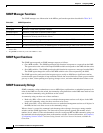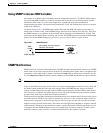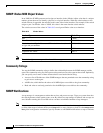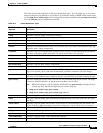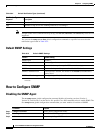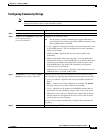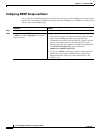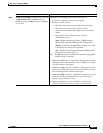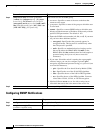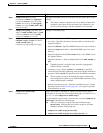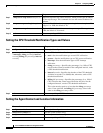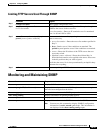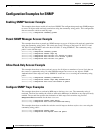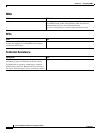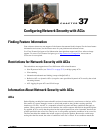
36-12
Cisco IE 2000 Switch Software Configuration Guide
OL-25866-01
Chapter 36 Configuring SNMP
How to Configure SNMP
Configuring SNMP Notifications
Step 4
snmp-server user username groupname
{remote host [udp-port port]} {v1 [access
access-list] | v2c [access access-list] | v3
[encrypted] [access access-list] [auth {md5 |
sha} auth-password]} [priv {des | 3des | aes
{128 | 192 | 256}} priv-password]
Adds a new user for an SNMP group.
• username—Specifies a name of the user on the host that
connects to the agent.
• groupname—Specifies a name of the group to which the user
is associated.
• remote—Specifies a remote SNMP entity to which the user
belongs and the hostname or IP address of that entity with the
optional UDP port number. The default is 162.
• Enters the SNMP version number (v1, v2c, or v3). If you enter
v3, you have these additional options:
–
encrypted—Specifies that the password appears in
encrypted format. This keyword is available only when
the v3 keyword is specified.
–
auth—Specifies an authentication level setting session
that can be either the HMAC-MD5-96 (md5) or the
HMAC-SHA-96 (sha) authentication level and requires a
password string auth-password (not to exceed 64
characters).
• If you enter v3 and the switch is running the cryptographic
software image, you can also configure a private (priv)
encryption algorithm and password string priv-password (not
to exceed 64 characters).
–
priv—Specifies the User-based Security Model (USM).
–
des—Specifies the use of the 56-bit DES algorithm.
–
3des—Specifies the use of the 168-bit DES algorithm.
–
aes—Specifies the use of the DES algorithm. You must
select either 128-bit, 192-bit, or 256-bit encryption.
• (Optional) Enters access access-list with a string (not to
exceed 64 characters) that is the name of the access list.
Step 5
end Returns to privileged EXEC mode.
Command Purpose
Step 1
configure terminal Enters global configuration mode.
Step 2
snmp-server engineID remote
ip-address engineid-string
Specifies the engine ID for the remote host.
Command Purpose



